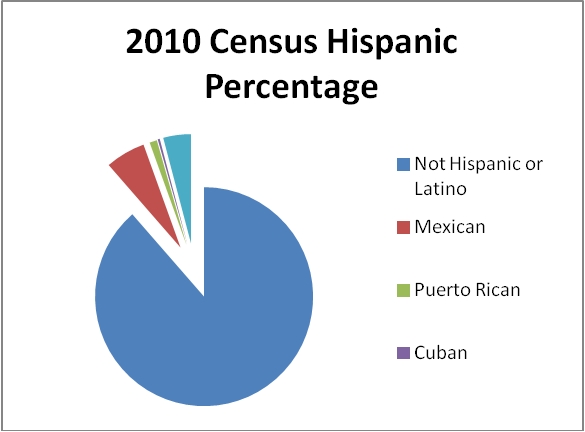With 46 percent population growth, Raleigh officially became one of the nation’s fastest-growing cities, according to the 2010 Census. The latest release of data show Latino residents, traditional family households, female householders with children and households with relatives account for much of Raleigh’s growth.
Race & Gender
 Raleigh’s Latino population grew more than 137 percent in the past decade. Among the population, highest growth rate was noted in the “other Hispanic or Latino” group (from 1.9 to 4.1 percent) with the Mexican population rising from 4.4 to 5.9 percent and smaller gains made by Puerto Rican and Cuban Raleigh residents.
Raleigh’s Latino population grew more than 137 percent in the past decade. Among the population, highest growth rate was noted in the “other Hispanic or Latino” group (from 1.9 to 4.1 percent) with the Mexican population rising from 4.4 to 5.9 percent and smaller gains made by Puerto Rican and Cuban Raleigh residents.
On a gender note, Raleigh’s female population rose slightly, from 50.5 percent in 2000 to 51.7 percent in 2010.
Households
Raleigh is now home to more families and growing families. The Census defines a “family” as “group of two or more people who reside together and who are related by birth, marriage, or adoption.” Family households now account for 55.9 percent of Raleigh households, compared to 54.5 percent in 2000.
The number of households with children under the age of 18 rose from 26.5 to 29 percent. The number of households headed by females without a husband present climbed from 2000’s 11.4 percent to 13.5 percent in 2010. Growth was also seen in the number of females heading households with their own children under 18; the percentage climbed slightly from 7.2 percent to 8.6 percent.
The average family size, regardless of the head of household, is now 3.06 persons compared to 2.97 a decade ago.
Non-family households, defined as people living together who are not related by birth, marriage or adoption, fell to 44.1 percent from 45.5 percent. The percentage of householders living alone dropped slightly to 32.8 percent compared to 33.1 percent in the 2000 Census.
Senior households, where someone aged 65 years or older is in residence, increased slightly to 15 percent from 14.4 percent 10 years ago.
Through The Ages
Age-wise, Raleigh has grown both younger and older. On the “senior” side, the most growth noted was in the 55- to 59-year-old and 60- to 64-year-old age groups, both of which rose 1.2 percent. The 65- to 74-year-old age group remained steady.
On the “junior” side, children under 5 years of age increased from 6.3 to 7.2 percent of the population in the past decade, with the 5- to 9-year-old group rising 0.5 percent and the 10 to 14 year old grouping rising 0.4 percent.
Conversely, Raleigh lost residents ages 25 to 34 years; the percentage fell from 20.7 percent to 18.4 percent. The 35 to 44 year age group dropped slightly, from 2000’s 15.9 percent to 15.2 percent in 2010.
Relationships
In the latest Census, the “married couple” category was replaced by the “husband-wife family” category, but the new definition provides even more detail. Family households consist of a householder and one or more other people related to the householder by birth, marriage, or adoption, but same-sex married couples are excluded unless there is at least one additional person related to the householder by birth or adoption. As a result, same-sex couple households without relatives are counted as nonfamily households.
The number of households holding “other relatives” rose from 4.9 percent to 5.2 percent; whereas those holding nonrelatives fell to 8.4 percent compared to 9.2 in 2000. A slight uptick was noted in unmarried partner households, which rose from 2.2 to 2.7 percent.
Housing Inventory
All the newcomers needed somewhere to live and Raleigh housing units increased by 45.9 percent. Occupied housing units (rental or owner-occupied) fell from 93.3 percent in 2000 to 92.5 percent in 2010. Vacant housing units rose from 6.7 percent to 7.5 percent, compared to a national average of 11.4 percent.
 Vacant rentals accounted for 8.3 percent of the total, compared to a national average of 9.2 percent. Homeowner vacancy rates totaled 2.1 percent, compared to a national average of 2.4 percent.
Vacant rentals accounted for 8.3 percent of the total, compared to a national average of 9.2 percent. Homeowner vacancy rates totaled 2.1 percent, compared to a national average of 2.4 percent.
Of Raleigh’s occupied housing units, owner-occupancies accounted for 51.6 percent of the total with renter-occupancies at 48.4 percent.
The average household size of owner-occupied units was 2.44 compared to the 2000 average of 2.43. Average renter-occupied housing units had an average household size of 2.26, up slightly from 2.15 percent in the last Census; the national average is 2.44.
The next release of Census 2010 data is due in a few months, but the exact date is unknown at this time. The future release will contain more detailed data on race, gender, age, relationships, households and housing.
